What is a Jib Crane? A Look at the Design, Types, and Components
Installing a jib crane, or a series of jib cranes, can increase production and improve workplace safety at your facility. Jib cranes are perfectly designed to handle high-volume lifts and provide an ergonomic means of moving material within a work cell, or in conjunction with an existing overhead crane system.
Do you feel like your workers are struggling to meet production quotas, or you’re missing that final piece to really streamline your production process? If so, you may want to consider a jib crane.
A jib crane is a type of overhead lifting device that’s often used in a smaller work cell area for repetitive and unique lifting tasks. Jib cranes are extremely versatile and can also be paired with overhead bridge cranes to maximize production.
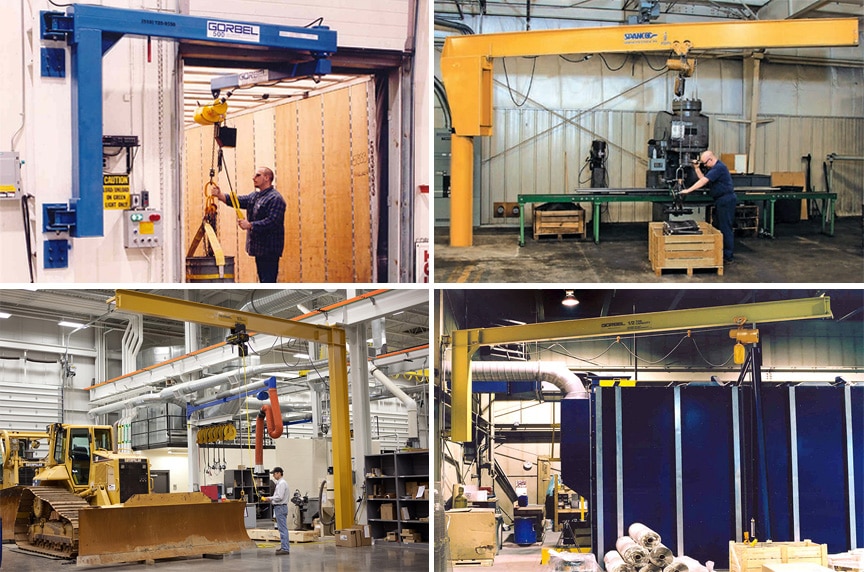
Jib cranes are fairly simple in design but can have capacities ranging anywhere from 250 lbs. to 15 tons in some applications. Their ergonomic design is very appealing in a production environment because they can increase worker productivity, reduce workplace injuries, and improve safety.
In this article, we’ll discuss the different types of jib cranes and the different components and configurations available. Our goal is to help you understand what type of jib crane system will be most beneficial for the needs of your operation.
Jib Crane Design and Components
For the most part, jib systems have a very basic design and construction. Compared to workstation cranes and bridge or gantry cranes, they’re simple to operate, and require less maintenance because they have less parts that could potentially breakdown or fail.
Below are some of the components and terms you’ll see mentioned throughout this article:
- Reach/Boom – the horizontal beam that the trolley travels back and forth on.
- Mast/Pillar – the vertical beam used to support the boom on freestanding and mast systems
- Movable Hoist – the hoist is used to lift, position, and lower a load.
- Trolley – the motion of the trolley can be manual, motorized, or pneumatic. The trolley carries the hoist, wire rope or chain, and the hook along the entire length of the boom.
- Rotation – on free standing and mast type jib cranes, you can achieve 360° of boom rotation. On wall and column-mounted jib cranes, you can achieve 180-200° of rotation.
- Electrification/Pneumatic Power – electric collector rings or pneumatic air lines can be added to the top or bottom of the mast to provide rotation assistance and allow for continuous 360° boom rotation.
- Controls – on motorized or air-powered jib systems, you can use a push button controller to control the rotation of the boom, as well as the motion of the trolley and the lifting and lowering motion of the hoist. Multi-speed or variable speed controls are available for the hoist and trolley.
- Hook Height – How high can you or do you want to go with your lifts? You’ll need to know the lowest overhead obstruction to know how tall your jib crane can be.
- Rotation Stop – if the crane is located close to a wall or other obstruction, a rotation stop will limit the crane’s motion before it collides with a nearby object.
- Environmental Considerations – the components of the jib system can be galvanized to resist corrosion for outdoor applications. Also, special control enclosures can be designed for explosion proof applications, and other environments where heat, dust and dirt, or moisture may be a factor.
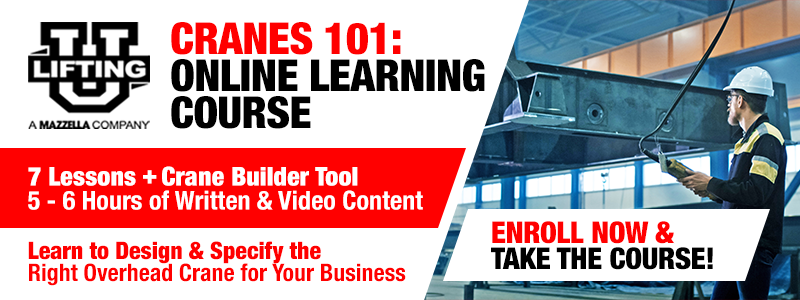
Different Types of Jib Crane Systems
Below we’ll discuss the different types of jib crane systems that are available, as well as provide each system’s range of capabilities, advantages and disadvantages, and available design options.
Freestanding Jib Cranes
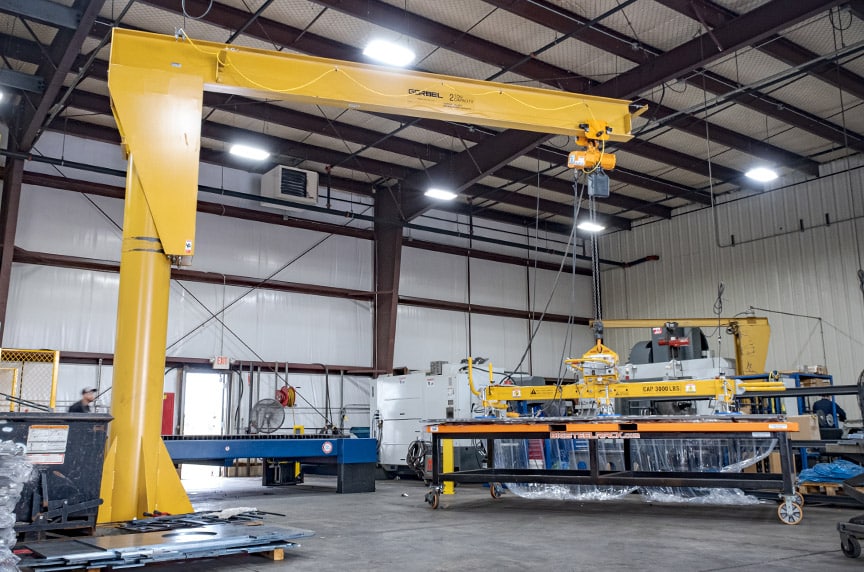
This is the most common type of jib system because they can be installed virtually anywhere including indoors or outdoors. Freestanding jib systems can be used underneath large bridge crane systems, or in open areas where they can support individual work cells. They can be used outdoors at marinas or loading docks, and indoors for machining and assembly operations where multiple jibs can be used in conjunction for staged operation.
Typically, freestanding jib crane systems can accommodate:
- Spans up to 50’
- Capacities up to 15 tons
- 360° of rotation
- Boom heights up to 40’
There are three main designs for freestanding jib cranes, in terms of how they can be mounted and installed:
- Base-Plate Mounted: These are the easiest to install and the most popular design. The mast is secured by bolting a base plate onto a reinforced concrete foundation and then reinforcing the mast with gussets.
- Foundation/Insert Mounted: These have a welded steel plate at the bottom of the mast which is anchored during the first-pour concrete footing. A second concrete pour supports the mast—eliminating the need for gussets.
- Sleeve-Insert Mounted: A sleeve is welded to a steel plate, which is used to position the sleeve by anchoring it to a first-pour concrete footing. A second pour then supports the sleeve and the mast is inserted into the sleeve, leveled, and then welded in place. This design allows for relocation of the jib system, if necessary, without damaging the mast.
Compared to other jib crane systems, freestanding systems offer the highest capacities, longest spans, and greatest amount of rotation. However, freestanding jib cranes are among the most expensive systems and the most permanent setup due to the special foundation that is required to anchor and secure the crane and support the load during a lift.
Foundationless Jib Cranes
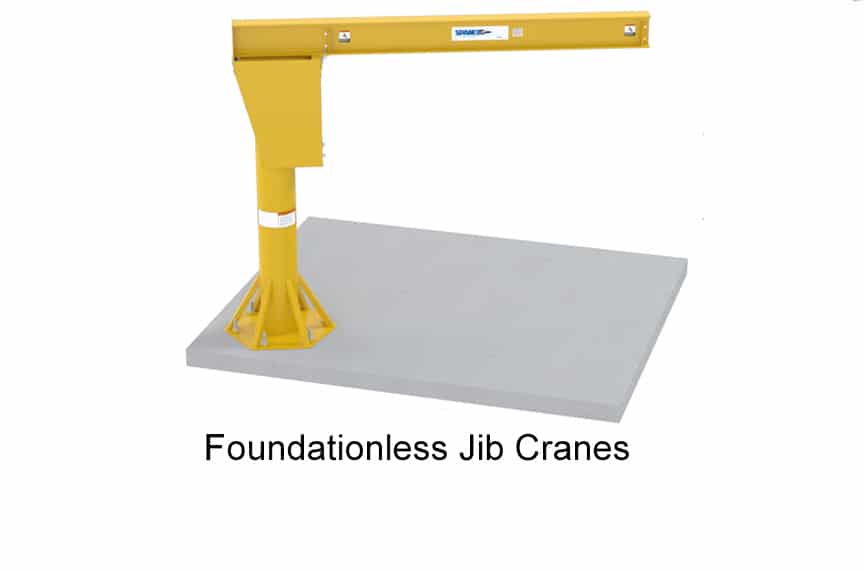
Foundationless jib cranes are another type of freestanding jib crane that are slab-mounted and bolted to 6″ reinforced concrete for indoor use. These types of jib crane systems don’t require a special poured foundation and can be installed almost anywhere in a facility as long as the area meets the requirements of the manufacturer.
Because there’s no special foundation required, these jib cranes can be installed faster because you don’t have to wait for a poured concrete foundation to cure. They can also be easily relocated within a facility, if necessary.
Typically, foundationless jib cranes can accomodate:
- 9-16′ spans
- Capacities up to 1,000 lbs.
- 360° rotation
- Boom heights up to 20′
While their ease of installation, cost-effectiveness, and portability make freestanding jibs attractive for certain applications, they do have a much lower capacity than typical freestanding jib cranes with a poured foundation.
Mast Type Jib Cranes
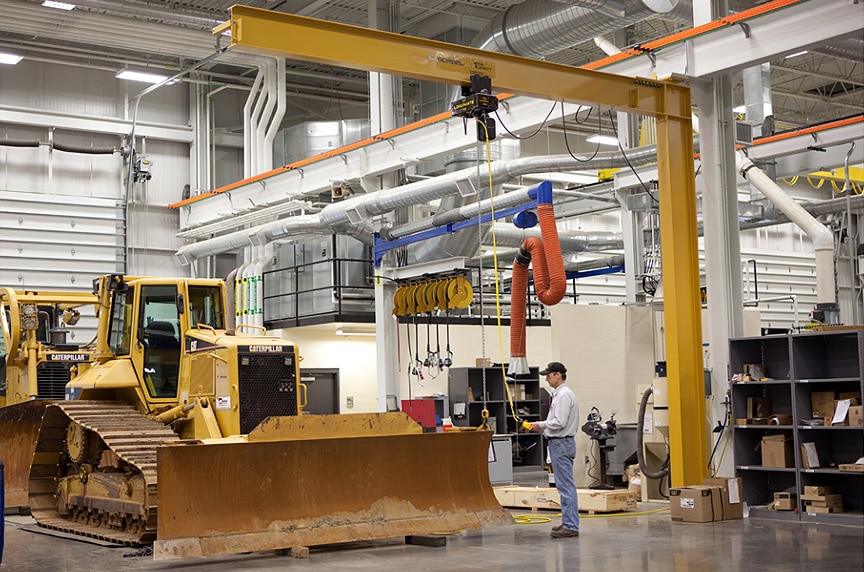
Mast type jib cranes are a cost-effective alternative to freestanding systems because they don’t require a special foundation. Mast type jib cranes only need 6” of reinforced concrete to support the crane because they require additional support from an existing overhead support beam or structure.
Typically mast type jib cranes can accommodate:
- 10-40’ spans
- Capacities up to 10 tons
- 360° rotation
- Boom heights up to 40’ (distance from floor to overhead top support)
There are two types of cantilever design options depending on the types of overhead obstructions that may or may not be present:
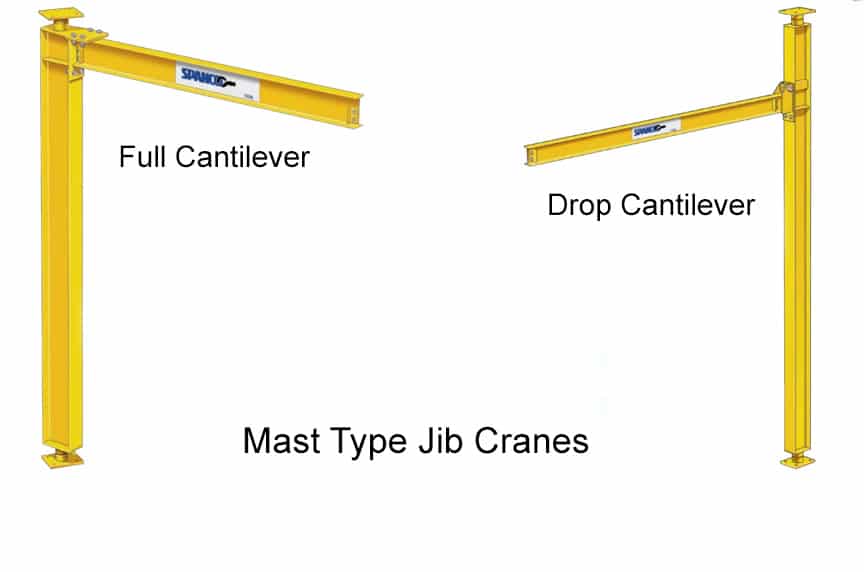
- Full Cantilever: These can be used when there are no overhead obstructions. The boom is mounted to the top of the mast which provides maximum lifting capability and maximum clearance underneath.
- Drop Cantilever: Side-plate connections allow the boom to be “drop mounted” at a specific height to allow for clearance for overhead obstructions located below the top of the mast.
Mast type jib cranes are similar to freestanding systems and can be used for the same type of heavy-duty/high-productivity applications. However, they do require an overhead beam or support structure to provide support in addition to the foundation.
Wall-Mounted Jib Cranes
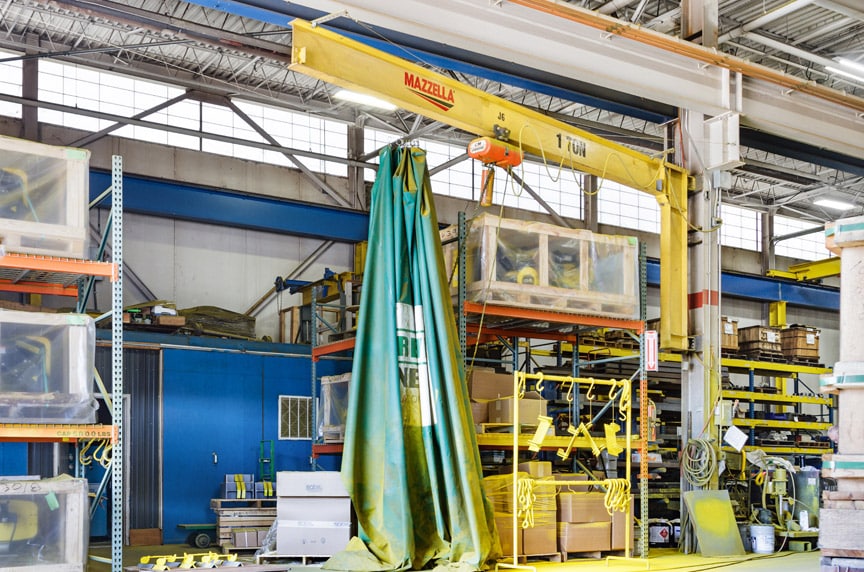
Wall-mounted jib crane systems can be used in individual bays, along structurally adequate walls or building support columns, or as a supplement to an existing monorail or overhead bridge crane. The main advantage of using a wall-mounted system is the space-savings that it offers. They don’t require any type of floor or foundation support, and they can also be installed very close to the underside of the lowest ceiling obstruction, providing maximum clearance both under and above the boom.
These systems can be designed to swing around obstacles, under obstructions, or fold out of the way of overhead cranes to ensure no interruption of production.
Wall or column-mounted jib cranes can accommodate:
- Spans ranging from 8-30’
- Capacities up to 5 tons
- 180°-200° rotation
Wall-mounted jib cranes can be designed to mount to a wall or building support column in two different ways:
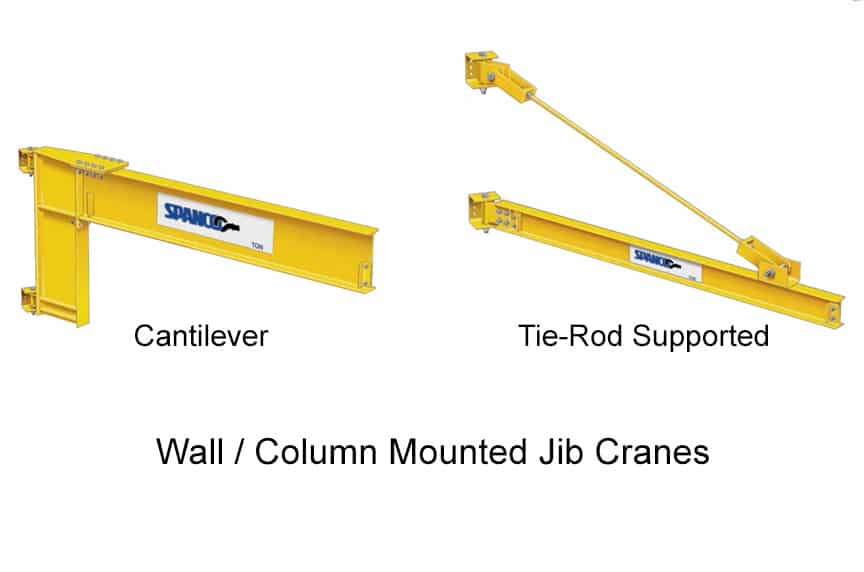
- Cantilever: Wall-mounted cantilever jib cranes offer the greatest amount of clearance, above and below the boom, and have a full-cantilever design
- Tie-Rod Supported: This is the most economical means of providing hoist coverage along walls or building columns. A wall bracket and single tie-rod supports the boom to allow the hoist full travel along the length of the beam.
While these types of jib systems are among the most economical in price and design, the major disadvantage of using a wall-mounted or column-mounted jib crane is that the design does not allow for full 360° of rotation. They also require a column or support capable of withstanding the loads, which typically requires a structural engineering survey and approval prior to installation.
Articulating Jib Cranes
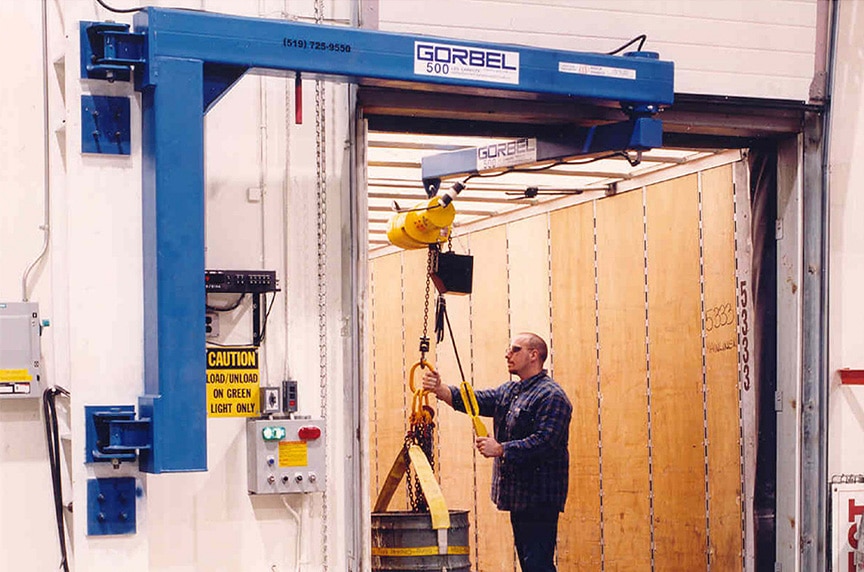
Compared to traditional jib cranes with one boom, articulating jib cranes have two swivel arms that can lift loads around corners and columns, and reach into or under machinery and containers. The primary boom arm allows for 200° swivel and the outer arm allows for up to 360° of rotation—providing a greater coverage area and more flexibility closer to the mast or column.
Articulating jib systems can be floor-mounted, wall-mounted, ceiling-mounted, or mounted on a bridge or track system. The variety of configurations allows for precise load positioning and spotting loads around obstructions, through open doors, or rotating in close to the mast or building column—an area where it can be more difficult to maneuver traditional jibs.
Articulating jib cranes can accommodate:
- Spans up to 16’
- Capacities up to 1 ton
- 360° rotation for freestanding and ceiling-mounted systems
- 180° inner arm/360° outer arm for wall-mounted systems
For heavier duty and more frequent lifts, an articulating jib crane might not be the best choice. Their design won’t allow for higher capacity lifts and their span is somewhat limited.
Wrapping it up
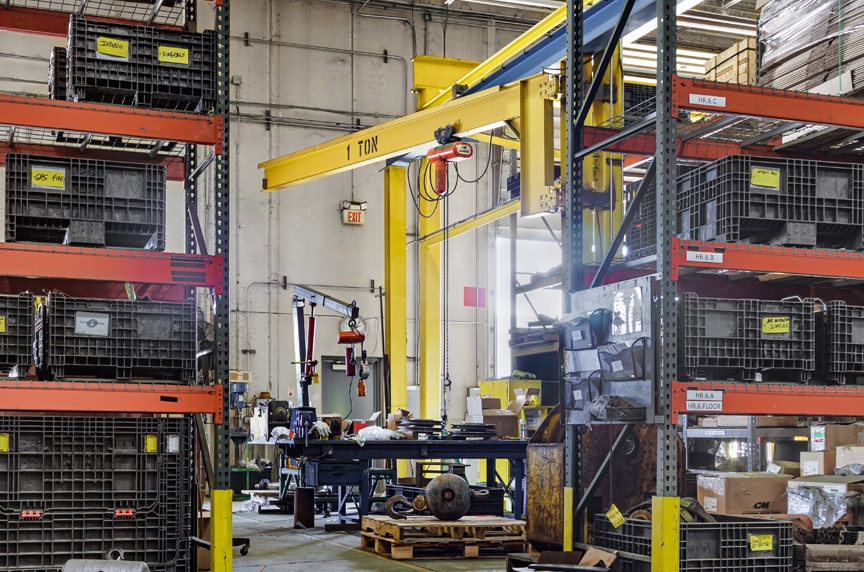
Installing a jib crane, or a series of jib cranes, can increase production and improve workplace safety at your facility by reducing workplace injuries. Jib cranes are perfectly designed to handle high-volume lifts and provide an ergonomic means of moving material within a work cell or in conjunction with an existing overhead crane system.
Keep the following in mind to make sure that you design a jib crane system that’s the most economical and most productive for your application:
- Duty Cycle/Classification: Selecting the right duty cycle or service classification helps ensure that the components are durable enough to withstand the load and usage requirements.
- Area of rotation: Freestanding and mast-style jib cranes offer 360-degree rotation; wall-mounted cranes offer 180-degree rotation.
- Height Under Boom: The distance from floor to underside of jib crane’s boom is the height under boom. Also factor in hoist size and lifting height needed.
- Overall jib crane height: Factor in any attachments, such as electrical entry, so that the crane will be free from overhead obstructions.
- Actual working span needed: The working (or hook) distance is roughly the length of the boom minus ½ trolley length at each end.
- Power requirements: Will you need power for your jib crane’s motor drive, its trolley, its hoist, or all three? Will the power supply be electric or air? Bottom or top entry? Indoor or outdoor use?
At Mazzella, we design and build world-class overhead crane systems. We have over 40 years of experience in the overhead crane industry and can build custom solutions ranging from light-duty economical cranes to large-capacity, high-duty cycle cranes.
Our expert team of Engineers, Estimators, and Project Managers can help you design and specify a cost-effective gantry jib crane system for your facility, production or budgetary needs. If you’re interested in scheduling a consultation, please don’t hesitate to contact us today.
If you’re interested in scheduling a consultation, please don’t hesitate to contact us today.
Images courtesy of Gorbel® Inc. and Spanco® Inc.

Copyright 2018. Mazzella Companies.
